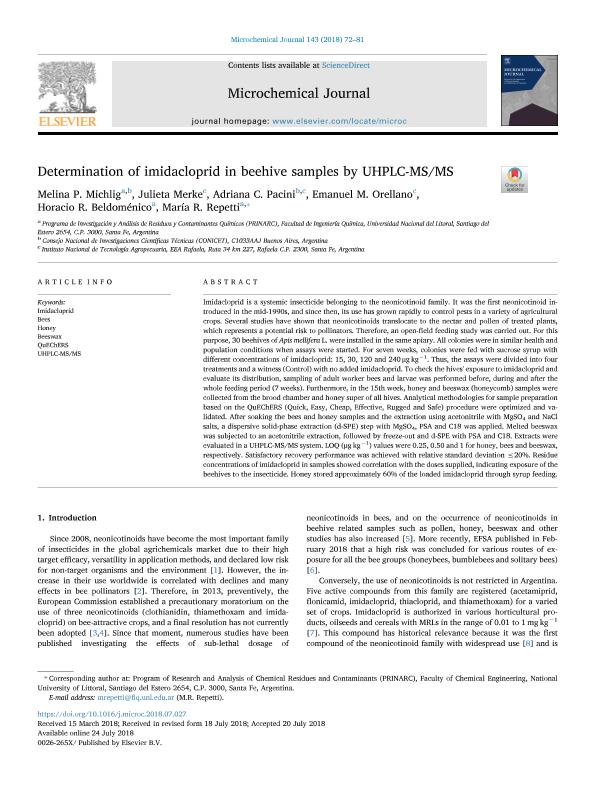Artículo
Determination of imidacloprid in beehive samples by UHPLC-MS/MS
Michlig, Melina Paola ; Merke, Julieta; Pacini, Adriana Cecilia
; Merke, Julieta; Pacini, Adriana Cecilia ; Orellano, Ramiro Emanuel; Beldomenico, Horacio Ramon; Repetti, María Rosa
; Orellano, Ramiro Emanuel; Beldomenico, Horacio Ramon; Repetti, María Rosa
 ; Merke, Julieta; Pacini, Adriana Cecilia
; Merke, Julieta; Pacini, Adriana Cecilia ; Orellano, Ramiro Emanuel; Beldomenico, Horacio Ramon; Repetti, María Rosa
; Orellano, Ramiro Emanuel; Beldomenico, Horacio Ramon; Repetti, María Rosa
Fecha de publicación:
12/2018
Editorial:
Elsevier Science
Revista:
Microchemical Journal
ISSN:
0026-265X
Idioma:
Inglés
Tipo de recurso:
Artículo publicado
Clasificación temática:
Resumen
Imidacloprid is a systemic insecticide belonging to the neonicotinoid family. It was the first neonicotinoid introduced in the mid-1990s, and since then, its use has grown rapidly to control pests in a variety of agricultural crops. Several studies have shown that neonicotinoids translocate to the nectar and pollen of treated plants, which represents a potential risk to pollinators. Therefore, an open-field feeding study was carried out. For this purpose, 30 beehives of Apis mellifera L. were installed in the same apiary. All colonies were in similar health and population conditions when assays were started. For seven weeks, colonies were fed with sucrose syrup with different concentrations of imidacloprid: 15, 30, 120 and 240 μg kg −1 . Thus, the assays were divided into four treatments and a witness (Control) with no added imidacloprid. To check the hives’ exposure to imidacloprid and evaluate its distribution, sampling of adult worker bees and larvae was performed before, during and after the whole feeding period (7 weeks). Furthermore, in the 15th week, honey and beeswax (honeycomb) samples were collected from the brood chamber and honey super of all hives. Analytical methodologies for sample preparation based on the QuEChERS (Quick, Easy, Cheap, Effective, Rugged and Safe) procedure were optimized and validated. After soaking the bees and honey samples and the extraction using acetonitrile with MgSO 4 and NaCl salts, a dispersive solid-phase extraction (d-SPE) step with MgSO 4 , PSA and C18 was applied. Melted beeswax was subjected to an acetonitrile extraction, followed by freeze-out and d-SPE with PSA and C18. Extracts were evaluated in a UHPLC-MS/MS system. LOQ (μg kg −1 ) values were 0.25, 0.50 and 1 for honey, bees and beeswax, respectively. Satisfactory recovery performance was achieved with relative standard deviation ≤20%. Residue concentrations of imidacloprid in samples showed correlation with the doses supplied, indicating exposure of the beehives to the insecticide. Honey stored approximately 60% of the loaded imidacloprid through syrup feeding.
Palabras clave:
Bees
,
Beeswax
,
Honey
,
Imidacloprid
,
Quechers
,
Uhplc-Ms/Ms
Archivos asociados
Licencia
Identificadores
Colecciones
Articulos(CCT - SANTA FE)
Articulos de CTRO.CIENTIFICO TECNOL.CONICET - SANTA FE
Articulos de CTRO.CIENTIFICO TECNOL.CONICET - SANTA FE
Citación
Michlig, Melina Paola; Merke, Julieta; Pacini, Adriana Cecilia; Orellano, Ramiro Emanuel; Beldomenico, Horacio Ramon; et al.; Determination of imidacloprid in beehive samples by UHPLC-MS/MS; Elsevier Science; Microchemical Journal; 143; 12-2018; 72-81
Compartir
Altmétricas



